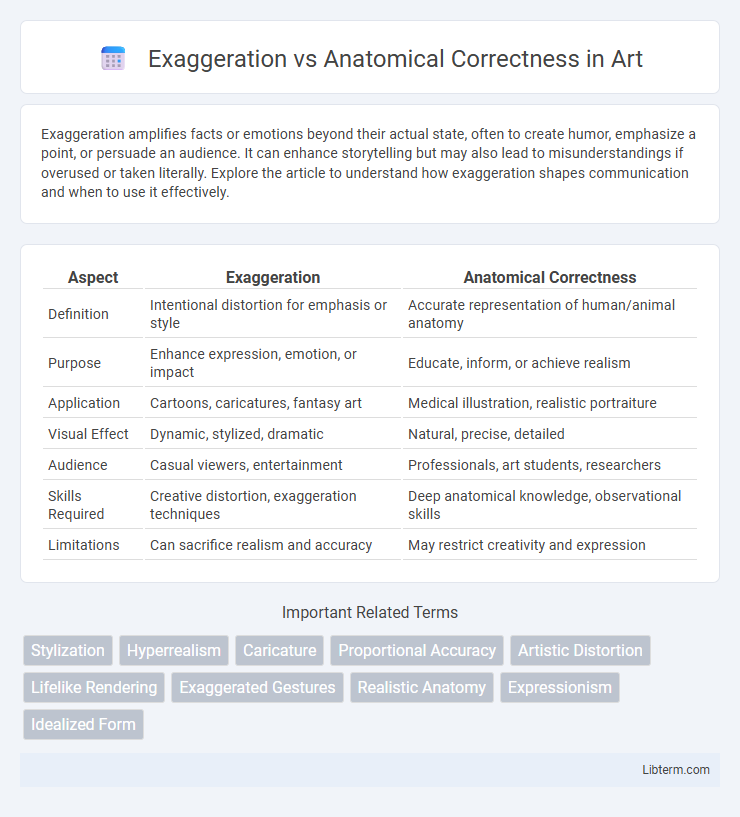Exaggeration amplifies facts or emotions beyond their actual state, often to create humor, emphasize a point, or persuade an audience. It can enhance storytelling but may also lead to misunderstandings if overused or taken literally. Explore the article to understand how exaggeration shapes communication and when to use it effectively.
Table of Comparison
| Aspect | Exaggeration | Anatomical Correctness |
|---|---|---|
| Definition | Intentional distortion for emphasis or style | Accurate representation of human/animal anatomy |
| Purpose | Enhance expression, emotion, or impact | Educate, inform, or achieve realism |
| Application | Cartoons, caricatures, fantasy art | Medical illustration, realistic portraiture |
| Visual Effect | Dynamic, stylized, dramatic | Natural, precise, detailed |
| Audience | Casual viewers, entertainment | Professionals, art students, researchers |
| Skills Required | Creative distortion, exaggeration techniques | Deep anatomical knowledge, observational skills |
| Limitations | Can sacrifice realism and accuracy | May restrict creativity and expression |
Introduction to Exaggeration and Anatomical Correctness
Exaggeration in art emphasizes distorted proportions and features to evoke emotion or highlight specific characteristics, often sacrificing realism for impact. Anatomical correctness adheres to accurate human or animal body structures based on scientific and medical knowledge, ensuring lifelike and believable representations. Balancing these approaches depends on the artistic goal, whether prioritizing expressive storytelling or precise anatomical fidelity.
Defining Exaggeration in Art and Illustration
Exaggeration in art and illustration emphasizes amplifying specific features or expressions beyond realistic proportions to convey emotion, humor, or character traits more vividly. This technique enhances visual storytelling by prioritizing impact and stylistic expression over anatomical accuracy. Exaggeration often contrasts with anatomical correctness, which adheres strictly to realistic human or animal forms to maintain believability.
Understanding Anatomical Correctness
Understanding anatomical correctness involves accurately representing human body proportions, muscle structure, and joint articulation to create realistic and believable figures. It requires detailed knowledge of skeletal landmarks, muscle groups, and the natural range of motion to avoid distortions that break immersion. Mastery of anatomical correctness enhances the credibility of character design, whether in art, animation, or medical illustration, by grounding exaggerated features in plausible human form.
Historical Context: Exaggeration vs Anatomical Accuracy
Historical artistic traditions often emphasized exaggeration to convey emotion and symbolism, evident in ancient Egyptian and medieval art where idealized forms transcended anatomical accuracy. Renaissance artists shifted focus toward anatomical correctness, driven by scientific studies of human anatomy and the rediscovery of classical ideals, enhancing realism in painting and sculpture. This evolution from stylization to precision reflects broader cultural values and technological advancements in understanding human physiology.
Purposes of Exaggeration in Artistic Expression
Exaggeration in artistic expression amplifies features or emotions to convey intensity, personality, or mood beyond realistic depiction, offering viewers a heightened interpretative experience. This technique diverges from anatomical correctness by deliberately distorting proportions to emphasize narrative elements or symbolic meanings, thus enhancing visual storytelling. Artists utilize exaggeration to evoke emotional responses, create dynamic compositions, and highlight specific traits that might be understated in anatomically accurate portrayals.
The Importance of Anatomical Correctness in Realism
Anatomical correctness is crucial for achieving realism in art and design, as it ensures accurate representation of human or animal forms, enhancing believability and viewer engagement. While exaggeration can add stylistic flair or emphasize emotions, excessive distortion risks breaking immersion by deviating too far from natural proportions and biological structure. Mastery of anatomical knowledge allows artists to balance realism with creative expression, maintaining authenticity without sacrificing dynamic impact.
Balancing Stylization and Accuracy
Balancing exaggeration and anatomical correctness requires maintaining the core proportions and joint placements while enhancing specific features for artistic impact, such as elongating limbs or accentuating muscle definition. Prioritizing key anatomical landmarks ensures that stylized characters remain believable and dynamic without sacrificing visual appeal. Effective stylization leverages exaggeration as a tool to emphasize character traits while preserving structural integrity.
Common Mistakes: When Exaggeration Goes Too Far
Common mistakes when exaggeration goes too far include distorting body proportions beyond believable limits, which disrupts anatomical correctness and can confuse the viewer's understanding of human form. Overemphasizing features like muscle size or limb length can lead to unnatural poses and strained visual flow. Maintaining a balance between exaggerated elements and accurate anatomical structure ensures dynamic yet credible character designs.
Techniques for Improving Anatomical Precision
Techniques for improving anatomical precision include detailed study of human anatomy through life drawing and reference materials, emphasizing bone structure, muscle groups, and joint articulation. Utilizing digital tools and 3D models allows artists to visualize complex anatomical forms from multiple angles, enhancing spatial understanding and accuracy. Regular practice combined with critical self-assessment sharpens the ability to balance exaggerated styles with anatomical correctness, resulting in more believable and dynamic figures.
Finding Your Artistic Voice: Combining Exaggeration and Correctness
Balancing exaggeration with anatomical correctness allows artists to develop a unique style that captures both realism and dynamic expression. Emphasizing key anatomical structures while strategically distorting proportions enhances storytelling and emotional impact. This synthesis of accuracy and creativity helps artists craft visually compelling characters that resonate with audiences and showcase their distinct artistic voice.
Exaggeration Infographic

 libterm.com
libterm.com